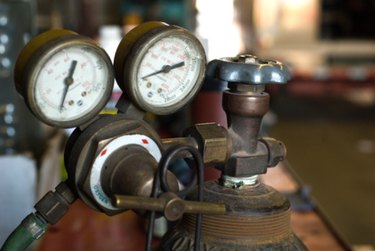
Cummins air compressors are used in a variety of projects, from pumping up the vehicle tires to powering hand pneumatic tools for engraving, drilling and other operations. When the air compressor stops working or starts making strange noises, you need to troubleshoot the problem and make any necessary fixes or replacements to get your Cummins air compressor back in proper working order.
Step 1
Check the power source and the electric cables. If the compressor is not functioning, make sure that the power source is constant and steady and there are no frays or shorts in the power cable. Replace any cords that are not functioning properly.
Video of the Day
Step 2
Examine the compressor's air intake and air filter. Building too much air pressure or having an oily discharge can result from a clogged intake and/or dirty filter. Replace the air filter and clear out any blockages in the air intake to see if that corrects air buildup or discharge problems.
Step 3
Examine the exterior of the air compressor. There should be no holes or cracks for air to slip from, which can lead to air escaping and even the compressor's case cracking open. If you find a crack, it needs to be professionally sealed or be replaced completely. If there's condensation forming on the case, then humidity may be causing problems with the motor. If excess water forms, move the air compressor to an area that's less humid and try running it again.
Step 4
Check the compressor's belts. If there's excess noise, the belts may be loose, fraying or getting caught in other pieces of machinery. Replace the old belts with new, tight belts and see if the noise goes away or lessens.
Step 5
If you are losing air pressure, it may be a faulty air valve. Close the safety valve once you've built up air pressure and put your hand near the opening to feel for escaping air. If the valve is letting out air, then replace it with a new valve.
Step 6
Check the oil in the air compressor. If oil is leaking, it may cause a shortage of oil circulating within the compressor, leading to excess heat and possibly the air compressor locking up. It can also lead to oil leaking into the air pressure canister or onto the ground. Seal the crack in the oil pan and replace the oil in the air compressor. Watch for any new leaks or problems that fixing the leak didn't solve.
Tip
Always check the air compressor's manual to see the individual components and to look for advice and steps for replacing specific parts. The manual should have part numbers for purchasing replacements.
Warning
If you're not sure how to replace a part or if the problem you find is beyond your ability to repair, hire a professional to repair the compressor. If the repair costs are prohibitive, get a new air compressor.
Video of the Day